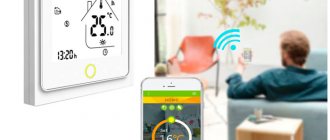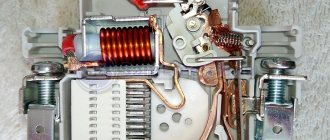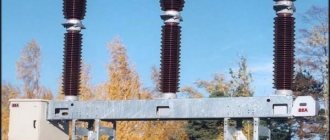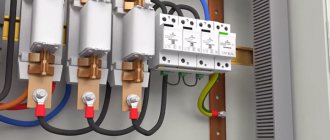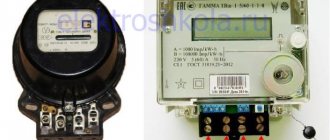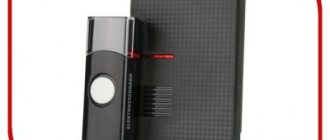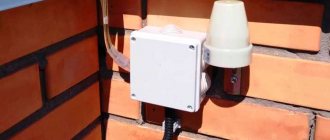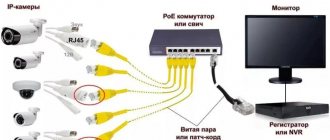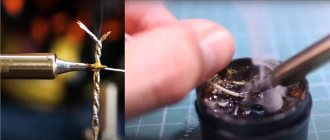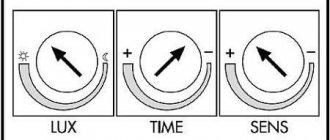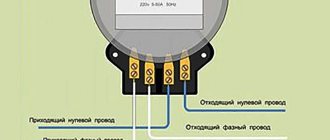RCD is a switching switch designed to stop the supply of voltage in certain circumstances. The device prevents electric shock to a person if they accidentally touch exposed contacts and live parts of the boiler. It also trips the RCD on the water heater if there is a threat of fire caused by an electrical leak due to broken insulation. There is a combined development - a difavtomat, in the housing of which a circuit breaker is combined with a residual current device (RCD).
Why connect a water heater through an RCD?
Water heaters are used to heat water and its further use for domestic needs. The heating element is a heating element operating from a mains voltage of 220 V. As a result, one device contains 2 factors that together pose a danger to human life:
- Water, high humidity. The water heater boiler is filled with water. The units are often installed in rooms with high humidity.
- Electric current circulating around the clock through the heater and power cables. Due to continuous operation, users forget to carry out timely technical inspection of the water heater.
Damage to the insulation of the heating element or the wiring of the water heater leads to leakage current. Voltage from the conductive parts reaches the water tank, and from it to the body of the unit.
If a person touches an emergency boiler without an RCD, he will inevitably receive an electric shock. Therefore, when connecting such units with voltage and water, it is recommended to use leakage current protection.
Additional Information. Powerful electrical consumers that use heating elements and water require connection to a grounded outlet. In this case, the power supply point must be connected to a PE wire connected to the building’s grounding loop. This also applies to compact instantaneous water heaters.
How an RCD for a water heater saves people from injury
Tap water contains impurities that contribute to the formation of scale and destruction of the body of the heating element of the water heater. This is true for both storage and flow-through heaters. If the heating element body is damaged, there is a high probability of electric shock through the heater body or through hot water. A heating element in a damaged state can work for quite a long time and not cause the automatic switch to trip, as happens with a short circuit. This creates a health hazard for users of such an electric water heater.
In some cases, electric heaters are installed and operated without grounding, which is incorrect, but sometimes occurs. This is especially true for country houses and similar structures, where the owners often do not bother themselves with arranging proper grounding. And the pipes are often not metal, but plastic, which further insulates them from grounding. In this case, a cable for a water heater with an RCD is simply a lifesaver. When touching water or the body of a heater in which the heating element is destroyed, a person will not be shocked by an electric shock, since the RCD will instantly disconnect the device from the network and the effect of the current on the body will not be traumatic.
And if there is a grounding, then if a breakdown occurs, the RCD for the water heater instantly trips and turns off the broken device, without waiting for a person to touch it or the hot water.
Differences between RCDs and circuit breakers
On sale there are 3 similar in appearance, but different in purpose, protection devices. People often don't understand the difference between them:
- circuit breaker;
- differential machine;
- residual current device.
The circuit breaker is designed to protect apartment electrical wiring from overloads and short-circuit currents. The device turns off the voltage if a short circuit occurs somewhere in the network between the phase and neutral wires. Or there are too many consumers connected to the outlet, whose total power exceeds the permissible limit.
The differential automatic machine also responds to overloads and short circuits. Additionally, it turns off the apartment when a differential leakage current occurs. For example, if the phase wire in the water heater is frayed and touches the grounded housing.
The residual current device reacts only to leakage currents. It will not turn off the apartment in case of overload or short circuit.
The difference between RCD and Difavtomat
Purpose of RCDs and difavtomats
To understand why RCDs or RCDs should be used to protect bathroom circuits, you need to know their operating principle and the tasks they are designed to perform.
An RCD or difavtomat, unlike a circuit breaker, operates on leakage current, which occurs when the external insulation of a conductor is broken or when conductivity occurs in materials that are dielectric in their properties.
How can a dielectric conduct electricity? This happens if, for example, the surface of the material is moistened or the material with a porous structure is saturated with moisture. And these conditions are precisely characteristic of objects in the bathroom.
Automatic switches will only operate when there is a short circuit between phase and zero, that is, when, for example, water gets into an electrical appliance or socket and short-circuits both conductors. However, for the human body, the case when a potential difference occurs between the phase and the “ground” is much more dangerous.
This can happen when a phase contact breaks down on the device body, which may be a consequence of water penetrating inside the body. Until a person touches the body, tension will not arise. Both the machine and the RCD will remain on.
But when touched, tension will occur, and the likelihood of this occurring increases due to the fact that the floor or walls in the bathroom may also be damp, which increases their conductivity.
In this case, the machine, unlike the RCD, will remain on, because the current passing through the body is unlikely to exceed the rated current at which the machine turns off.
Types of residual current devices
Manufactured RCD models differ in maximum current, shutdown speed and number of connected phases. Some devices have a shutdown delay. Others don't have it. Therefore, all such devices are usually divided according to technical characteristics.
From the point of view of leakage current, residual current devices are of 4 types:
- “AC” - alternating current with a frequency of 50 Hz (the most common models);
- “A” - alternating or pulsed current;
- "B" - alternating and direct current.
RCD Andeli ADB1L-63, 2 poles, 25 A, 30 mA, type AC
Based on the number of protected phases, RCDs are:
- single-phase (1 phase and zero are connected to the device);
- three-phase (3 phases and zero).
According to the method of interrupting the circuit:
- electronic;
- relay.
RCD on the power cable
Residual current devices installed on the cable are separately noted. These devices are mounted directly on the supply wire of the water heater. There is no need to buy them separately. They are usually installed next to the plug.
An electrical cable with an RCD is superior to conventional protection devices mounted on a DIN rail. To operate them, you do not need to calculate leakage currents and do unnecessary electrical work.
Types of differential switches
RCDs installed with water heaters and other electrical appliances are divided according to the nature of the leakage current, operating current, number of phases, as well as the presence/absence of a delay and the technology of operation of the protection device.
All RCD models according to the type of leakage current are divided into three types:
- “A” – designed to be triggered by alternating and pulsating electric current;
- “AC” - inexpensive household devices that operate only from alternating current;
- “B” - industrial options, designed to work in networks with alternating, direct and rectified electric current.
If there is an “S” , then this is a device with an adjustable selective response delay. It breaks the chain only after a strictly set time, and not immediately. Such devices are used in cascade protection systems with multiple circuits. They are practically not used in everyday life.
According to the principle of circuit breaking, RCDs are:
Electromechanical models do not require separate external power and are more reliable. However, they also cost more than the latter. But, despite the high price, it is recommended to install electromechanical devices.
Electronic analogues during voltage surges reduce the efficiency of the device - in such situations their response time increases. Plus, if the neutral wire is accidentally damaged, such an RCD will simply stop working without power.
Selection of protective device
When choosing an RCD for a boiler, it is necessary to take into account its technical characteristics. The main ones include the following:
- Operating current. Determined by the power of the water heater.
- Differential current. Depends on operating current.
By working is meant the current passed through the power contacts of the protective device. It directly depends on the power of the water heater. For example, if the boiler power is 2.5 kW, then the operating current is 2500/220 = 11.4 A. It is advisable to select the RCD with a margin of operating current. In this case, a 16 A device is suitable.
The differential current (leakage) is determined from the operating current of the consumer. For a boiler with a power of 2.5 kW and a current consumption of 11.4 A, an RCD with a leakage current equal to 11.4 * 0.4 = 4.6 mA will be required. This figure is approximate. It is influenced by the length and condition of the electrical wiring. Therefore, in everyday life, residual current devices with a leakage current of 30 mA are usually installed.
Additional Information. Current leaks also exist in fully operational equipment and wires. However, their level is minimal and is about 10 μA. If the cables are old, then the leakage value increases many times. Therefore, RCDs are not recommended for use with old equipment or wiring.
Types and sizes of electrical panels
We will talk about cabinets/drawers for installing automatic machines and other electrical equipment, and their varieties. Depending on the type of installation, electrical panels are available for outdoor and indoor installations. The box for outdoor installation is attached to the wall with dowels. If the walls are flammable, an insulating material that does not conduct current is placed underneath. When mounted, the external electrical panel protrudes above the wall surface by about 12-18 cm. This must be taken into account when choosing its installation location: for ease of maintenance, the panel is mounted so that all its parts are approximately at eye level. This is convenient when working, but can pose a risk of injury (sharp corners) if the location for the cabinet is poorly chosen. The best option is behind the door or closer to the corner: so that there is no possibility of hitting your head.
Electrical panel housing for outdoor installation
A panel for hidden installation requires the presence of a niche: it is installed and walled up. The door is flush with the wall surface; it may protrude a few millimeters, depending on the installation and design of the particular cabinet.
The cases are metal, powder-coated, and plastic. Doors are solid or with transparent plastic inserts. Various sizes - elongated, wide, square. In principle, you can find a suitable option for any niche or conditions.
One piece of advice: if possible, choose a larger cabinet: it’s easier to work in, this is especially important if you’re assembling an electrical panel with your own hands for the first time
Complete set and installation of a mounted distribution panel
When choosing a building, they often operate on such a concept as the number of seats. This refers to how many single-pole circuit breakers (12 mm thick) can be installed in a given housing. You have a diagram with all the devices listed on it. You count them taking into account the fact that bipolar ones have double width, add about 20%! n (MISSING) and the development of the network (suddenly buy another device, but there will be nowhere to connect, or during installation you decide to make two from one group, etc. .P.). And for such a number of “seating” places, look for a shield with a suitable geometry.
3
Connection tools - what we need
Installing circuit breakers is a rather complicated process, but with due care, anyone can perform all the operations. Opening the switchboard, you see that the electrical equipment is attached to a special DIN rail using a special latch. The width of this rail is 35 mm.
Installing circuit breakers can be challenging
The following is a list of the main tools that will be required when installing meters:
Indicator screwdriverStripper - a special tool used when stripping insulation Cable cutter or regular wire cutters Pliers of various sizes Set of screwdrivers with Phillips and straight slots Crimper - a device for crimping lugs when working with stranded wires.
Connection diagram to the water heater
According to the rules, the RCD is installed in front of the water heater. If the device is made with fasteners on a DIN rail, then it is most convenient to place it in the incoming electrical panel of the apartment.
A residual current device must be installed after the machine and the meter. The circuit is assembled in the following sequence:
- A general circuit breaker is connected to the input cable. It is necessary to protect all apartment wiring from short circuits.
- After the introductory machine, a counter is connected. In the case of an ordinary apartment, this is a single-phase device.
- After the meter there is a separate circuit breaker to protect the water heater line. Selected according to the power of the heating element.
- The RCD itself. During installation, you must sign what exactly it protects.
- Boiler socket. It is advisable to use a ceramic modification.
If the water heater has a wire with an RCD, then it is quite possible to leave it. An additional redundant protection device would not hurt. On the contrary, the power supply system will become even safer.
Common connection errors
Connecting protection is not a difficult task. However, minimal electrical skills and an understanding of the operating principles of RCDs, automatic devices and other switchboard equipment are required. The most common mistakes are:
- To connect a water heater, one automatic device or RCD is not enough. These protective devices have an identical body, but perform different tasks. Both protection devices are always required.
- The operating current of the residual current device is selected either equal to the current of the machine, or slightly greater than it. If the circuit breaker in the water heater line is rated at 16 A, then the RCD must have a similar amperage.
- It is unacceptable to connect the grounding and neutral conductors after the RCD. Otherwise, false protection triggers are possible.
- Do not install RCDs, sockets and other electrical devices under the water heater. If a leak occurs, water from the boiler will leak into electrical equipment, causing a short circuit, fire, or injury.
- An electrician, not a seller of electrical goods, should choose an RCD based on its characteristics. If you purchase a protective device with too little leakage current, it will trip for no reason. If it's too big, it won't work at all.
You cannot install an outlet under the water heater.
First start-up of instantaneous water heater
When the hot water supply is turned off, close the DHW tap at the entrance to the house or apartment.
Cold water remains open. Next, open both shut-off valves on the water heater.
After this, turn on any hot water tap in the kitchen or bathroom for 20-30 seconds.
Thus, you pass cold water through the device, expelling accumulated air from all tubes and cavities. Only after all these manipulations can you turn on the machine in the panel.
When starting up for the first time, it is advisable to select the default power, and then change the heating modes and temperature according to your needs.
Such an instantaneous water heater is started for the entire season when the hot water supply is turned off. You don't need to click it back and forth every day.
All modern models work on a simple principle - there is a water supply through it, it heats. If not, it is disabled in standby mode.
That is, it does not constantly heat the water inside itself according to the principle of the same boiler.
After hot water has been restarted in the central system, perform all operations in the reverse order:
turn off the machine
close the shut-off valve of the heater
open the DHW tap at the inlet
https://youtube.com/watch?v=-k29H5YNinM%3F
Reasons for false alarms of RCDs
The cause of false alarms of the RCD is both a malfunction of the protective device itself and problems with the water heater. When searching for a problem, it is important to find out which of these 2 nodes it is located in.
Malfunctions of the residual current device:
- Dust, dirt, and water got into the RCD. Switch off the voltage and clean the protection device.
- The electronic circuit inside the protection device is faulty. The RCD will have to be replaced with a new one.
- The “Test” button is stuck (jammed). This usually happens due to dirt. Clean the button and make it moveable.
- The boiler power cord is damaged. It is necessary to find a place with broken insulation. Then restore the current-carrying conductors and insulation. If there are several such points, it is advisable to replace the cable with a new one.
Additional Information. Sudden changes in room temperature can lead to condensation of moisture from the air on cold metal surfaces. Therefore, the contacts of the RCD and its internal elements, when rapidly cooled in a damp room, become covered with small drops of water. This factor can lead to false alarms of the device.
Water heater malfunctions:
- The heating element is damaged. The heating element must be replaced.
- Water leakage onto live parts. The leak needs to be fixed.
- Increased air humidity in the room. Found in basements. The exhaust needs to be adjusted.
RCD trips when turned on
Here we are talking about a new boiler and RCD. The water heater and protective device were purchased at the store and installed in the proper place. The residual current device is activated the first time it is turned on.
This usually happens due to improper installation. The following points need to be checked.
- integrity of the power cable;
- correct connection of wires to the protection device and the boiler;
- whether the dowel that holds the water heater got into the cable laid in the wall;
- no leaks in the water heater tank.
The best RCD manufacturers
The market for modern automatic equipment designed to monitor and control electrical systems is experiencing a period of active growth. Established manufacturers and promising newcomers are trying to offer the client the highest quality products with good functionality.
ABB Automatic Products
The Swiss-Swedish company ABB has confidently held the leading position in this segment for many years. Residual current devices manufactured at the company's production facilities are considered very reliable, durable and completely safe.
At the same time, in all respects they meet the latest requirements imposed in the EU for equipment and accessories of this kind.
ABB modules are more expensive than similar domestically produced devices. However, experts claim that all costs are completely justified, since RCDs of this brand are many times higher in all respects than similar devices of other brands
In the manufacture of its devices, the company uses innovative materials and parts with unsurpassed high operational stability. The range of models is very wide and satisfies the needs of electrical systems of any power and complexity.
What does IEK offer users?
IEK is a leading domestic manufacturer and supplier of lighting and electrical products. It has been successfully operating in the Russian and post-Soviet markets for more than 17 years. It creates a variety of high-quality equipment and provides an extended warranty for its products.
Residual current units from IEK are in great demand in Ukraine, Russia and Belarus due to the combination of optimal quality and affordable cost. The products are included in the line of budget products and allow you to equip the safety of your electrical system at a reasonable price.
IEK products sell very well due to the price, which is significantly lower than the cost of products from world brands
Each device fully complies with the declared characteristics and, when used correctly under the conditions described by the manufacturer, always performs for the prescribed period.
True, buyers sometimes complain that the devices have a weak plastic case that can crack or come apart if the clamping screws are tightened and often make a hum, even when there is very little load on them. But nevertheless, these disadvantages have practically no effect on IEK’s turnover, which only increases from year to year.
Nuances of products from the Kontaktor company
The Kontaktor plant is one of the largest-scale production facilities engaged in the manufacture of electrical products and related parts in Russia. Since 2007, it has been part of the group of companies that own the famous French brand Legrand. The concern specializes in the creation of lighting and electrical equipment.
Electricians and electricians speak very highly of the products of the Kontaktor plant and call them one of the highest quality, reliable and durable among products of budget Russian brands
The peculiarity of the plant’s products is that they are made in the same way as at Legrand’s European enterprises, and the cost does not exceed the price of similar domestically produced devices.
Manufacturers of protective devices
Most modern water heaters are equipped with a plug with an RCD. If assembly is poor or incorrectly connected, the protective device on the cable may fail. In such a situation, there is no need to replace the entire water heater. It is enough to purchase a cable with an RCD. And here it is important to take into account the model of the water heater.
Cable with RCD for Termex water heaters
The cable length is 1.5 m. A standard Euro plug is used to connect to the network. The protective device on the Thermex cable is capable of passing current up to 10 A, which corresponds to a water heater with a power of up to 2.2 kW. The maximum leakage current declared by the manufacturer is 30 mA.
Cable for Ariston
The wire is 1 m long. The RCD is located next to the plug. There are a pair of mounting holes that allow you to screw the protective device to the wall. The maximum RCD current for Ariston water heaters reaches 10 A, which allows the use of boilers with a capacity of 2.2 kW. The protective device is set to a leakage current of 15 mA.
Grost
Universal cable with RCD, suitable for connecting water heaters and other household appliances. At one end of the cord there is a Euro plug. On the other there is a socket. Between them is a block with a residual current device. This design allows you to use the cable to connect not only water heaters, but also kettles, irons, washing machines and other devices. The device is designed for a load with a current of 16 A (3.5 kW).
Socket with RCD
Some manufacturers of electrical goods produce sockets in which an RCD is installed. Externally, they represent a normal power consumption point with two plug holes. The socket body has a “Test” button and an on/off switch.
An excellent solution if the water heater is not equipped with its own protective device and you don’t want to mess around in the electrical panel. In the future, you can plug into such an outlet any electrical appliances that are suitable in terms of power.
Socket with residual current device
Any water heater must be equipped with a protective shutdown device. This measure almost completely eliminates electric shock to a person. If the boiler cable does not have a built-in RCD, it must be purchased separately.
When choosing a protective device, you should pay attention to its maximum operating current. The second important parameter is the leakage current at which the RCD will trip and disconnect the load. When choosing protective equipment, it is better to consult an experienced electrician.
Possible installation errors
Mistake #1 . In order for the RCD to work correctly, contacts between the “working zero” and “ground” are not allowed in the protected circuit. Each of these wires must have its own bus. At the same time, “grounding” is not present at all in connecting the protection device. This conductor is not connected to it anywhere.
The power wire from the electrical panel is connected to the upper terminals of the RCD, from the lower terminals the line goes to the water heater - on the contrary, wires cannot be connected (+)
Mistake #2 . The operating current of the RCD is selected to be the same or slightly exceed the operating current of the machine in the circuit. Only in this way can the circuit breaker protect the protective device itself from overloads.
Mistake #3 . Inexperienced electricians often install sockets and RCDs directly under the water heater. This is strictly not recommended.
Leaks from hot water titanium cannot be completely excluded, and with such a layout of sockets and other electrical appliances with exposed wires under a potential “waterfall”, tragedy is not so far away.
Mistake #4 . The water heater cannot be connected only through an RCD or one automatic circuit breaker. These devices complement, but do not duplicate each other. They protect the boiler from fundamentally different problematic situations in the electrical network.
Mistake #5 . If you choose an RCD that is too sensitive (with a low leakage current), then it will trigger too often to block the circuit. The water heater will constantly turn off. As a result, the water will not heat up normally and the boiler may fail due to continuous switching on/off.
After completing the electrical installation, it is necessary to check the functionality of the RCD. To do this, most water heaters have a “TEST” function, which simulates current leakage. If everything is connected correctly and the protection is working, then the latter will trip and de-energize the boiler.
Otherwise, you need to look at where and what is not working as expected. It is recommended to carry out such checks once a month and thereafter.
Is it necessary to ground a water heater in an apartment or not: recommendations and tips
Our article will tell you about the need to ground water heaters, how to do it correctly in different ways, and how not to ground them.
- We ground the water heater correctly
- Is it worth grounding a water heater in an apartment or in a house?
- Instructions
- Grounding installation diagram: square and triangle
- Correct connection of a boiler with a storage tank in the bathroom
- How to connect a shower water heater without grounding
- Instantaneous water heater without grounding
- What grounding options should not be used?
- Useful video
How does a protective device function without a ground?
The connection option without grounding is a typical case for apartments and private houses in old buildings. The power supply of such buildings, as a rule, is organized without the supply of a grounding bus. But how correct should one expect the RCD to operate without turning on the ground?
For example, during the operation of electrical equipment, a breakdown occurred on the housing. If there is no grounding bus, you cannot count on instantaneous operation of the installed RCD. If a person touches the body of the broken equipment, the leakage current will flow to the “ground” through the person’s body.
It will take some period of time (device setting threshold) until the RCD trips. During this period of time (quite short), the risk of injury from exposure to electric current remains quite acceptable. Meanwhile, the RCD would operate immediately if there was a grounding bus.
Using this example, it is easy to draw the conclusion that you should always connect RCDs and circuit breakers in an apartment panel or panel of a private house together with a connection to the grounding bus. Another question is that there remain a sufficient number of buildings where it is not possible to do this due to the lack of “land” in the project schemes.
For buildings where the power supply is organized without grounding, the device of switching protection through an RCD actually appears to be the only effective means of protection that can be used in such conditions. Therefore, we will consider possible schemes applicable to the power supply of private housing.
